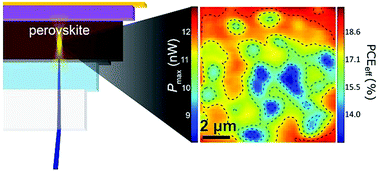A quantitative and spatially resolved analysis of the performance-bottleneck in high efficiency, planar hybrid perovskite solar cells†
Abstract
Hybrid perovskites represent a potential paradigm shift for the creation of low-cost solar cells. Current power conversion efficiencies (PCEs) exceed 22%. However, despite this, record PCEs are still far from their theoretical Shockley–Queisser limit of 31%. To increase these PCE values, there is a pressing need to understand, quantify and microscopically model charge recombination processes in full working devices. Here, we present a complete microscopic account of charge recombination processes in high efficiency (18–19% PCE) hybrid perovskite (mixed cation and methylammonium lead iodide) solar cells. We employ diffraction-limited optical measurements along with relevant kinetic modeling to establish, for the first time, local photoluminescence quantum yields, trap densities, trapping efficiencies, charge extraction efficiencies, quasi-Fermi-level splitting, and effective PCE estimates. Correlations between these spatially resolved parameters, in turn, allow us to conclude that intrinsic electron traps in the perovskite active layers limit the performance of these state-of-the-art hybrid perovskite solar cells.



 Please wait while we load your content...
Please wait while we load your content...